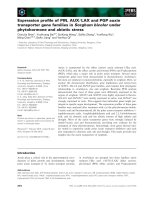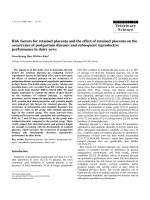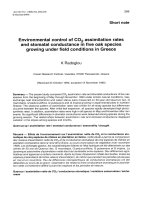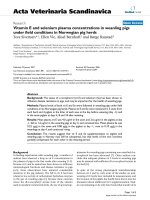Incidence of silent oestrus and an investigation of reproductive status in crossbred cows under field conditions of assam
Bạn đang xem bản rút gọn của tài liệu. Xem và tải ngay bản đầy đủ của tài liệu tại đây (139.51 KB, 4 trang )
Int.J.Curr.Microbiol.App.Sci (2019) 8(5): 1922-1925
International Journal of Current Microbiology and Applied Sciences
ISSN: 2319-7706 Volume 8 Number 05 (2019)
Journal homepage:
Original Research Article
/>
Incidence of Silent Oestrus and an Investigation of Reproductive Status in
Crossbred Cows under Field Conditions of Assam
D. Bharali1*, K.C. Deka2, B.C. Deka2, K.C. Nath2,
R.K. Biswas2, L.J. Dutta2 and B.K. Sarmah3
1
Livestock Research Station, AAU, Mondira, Kamrup, Assam, India
Department of Animal Reproduction, Gynaecology & Obstetrics, 3Department of Animal
Physiology, College of Veterinary Science, AAU, Khanapara, Guwahati-781022, Assam, India
2
*Corresponding author
ABSTRACT
Keywords
Crossbred cows,
Postpartum, Perrectum, Silent
oestrus, Incidence
Article Info
Accepted:
15 April 2019
Available Online:
10 May 2019
The present study was carried out in a total of 673 postpartum crossbred cows of first to
fifth lactations maintained under stall fed conditions at different Government and private
farms from Kamrup Metro, Cachar and Udalguri district of Assam. All the postpartum
crossbred cows were examined per rectum to determine the reproductive status based on
the owner’s history and the incidence of cows with silent oestrus was worked out. Results
revealed that a total of 86 crossbred cows (12.78%) reported to be anestrous were
identified as silent oestrus on the basis of presence of either uterine tone or corpus luteum
or Graafian follicle on clinico-gynaecological examination. The district-wise incidence of
silent oestrus was found to be 14.29, 10.08 and 14.25 per cent in Kamrup Metro, Cachar
and Udalguri district respectively. Reproductive status of the crossbred cows other than
anoestrus investigated were pregnant, recently calved, repeat breeder, true anoestrus,
chronic cervicitis, metritis, ovaro-bursal adhesion, cystic ovary and normal oestrus with
the percentage frequencies of 11.44, 8.02, 22.88, 26.11, 2.67, 11.00, 0.30, 0.44 and 4.31
respectively when estimated out of the total number of postpartum cows.
Introduction
Silent oestrus causes huge economic losses to
the dairy farmers by increasing calving-toconception interval. Mostly the new dairy
entrepreneurs are affected specially in semi
urban and rural areas. Silent oestrus is
clinically characterized by failure to exhibit
behavioural signs of oestrus, though the
animal is surprisingly normal. Follicular
development and ovulation occur normally in
animals affected with silent oestrus. Silent
oestrus is common during the post pubertal
period in heifers and early postpartum (30 to
120 days) in high yielding dairy cows.
Progesterone secreted from regressing CL of
previous cycle potentiates the action of
oestrogen and seems to favour the
manifestation of oestrus in next cycle (King et
al., 1976; Allrich, 1994). Thus, lack of
progesterone priming results in sub–oestrus or
silent oestrus. Other causes of sub oestrus are
1922
Int.J.Curr.Microbiol.App.Sci (2019) 8(5): 1922-1925
genetic factor, heat stress, nutritional
deficiencies, overweight, foot lesions and
aging. But most common cause considered for
silent oestrus is the failure of oestrus
detection. Oestrus detection failure is the most
common management factor contributing to
higher incidence of silent oestrus in high
yielding cows. Proper and timely detection of
oestrus is a very much necessary tool in
planned breeding programme for economic
development of a dairy herd.
Materials and Methods
The present study was carried out in a total of
673 postpartum crossbred cows of first to fifth
lactations maintained under stall fed
conditions at different Government and
private farms from three districts of Assam
viz. Kamrup Metro, Cachar and Udalguri. The
postpartum cross bred cows which failed to
exhibit oestrus symptoms till 90 days after
parturition were investigated and the cows
which had palpable structures on either of the
ovary or had genital changes like that of an
oestrus cow were categorized as silent estrous
cows.
The postpartum breedable cows under the
present study were surveyed at different
Government and private farms from the above
mentioned districts of Assam and the
incidence of cows with silent oestrus was
worked out on the basis of owners’ reports
and clinico-gynaecological examination.
Results and Discussion
During the period of study a clinicogynaecological survey was conducted in
different dairy pockets of Kamrup Metro,
Cachar and Udalguri districts of Assam to
find out the incidence of silent oestrus
condition in crossbred cattle. A total of 673
crossbred postpartum cows were examined
per rectum to determine the reproductive
status based on the farm or owner’s history or
record, genital changes and incidence of silent
oestrus condition was worked out (Table 1).
Under this study only cows of first to fifth
lactation with milk yield from 8-20 litres were
investigated.
Results of the present study revealed that a
total of 86 crossbred cows (12.78%) reported
to be an oestrus were identified as silent
oestrus on the basis of presence of either
uterine tone or corpus luteum or Graafian
follicle on per rectal examination. The
district-wise incidence was 14.29, 10.08 and
14.25 per cent in Kamrup Metro, Cachar and
Udalguri district respectively. The incidence
of silent estrous cows under the present study
was similar with the report of Arthur et al.,
(1989) and Iyer et al., (1992) but it was less
than that reported by Kakar et al., (1997) and
higher than that reported by Bonia and
Baishya (2011).
The reproductive status other than silent
oestrus under the present study i.e. pregnant,
recently calved, repeat breeder, true
anoestrus, chronic cervicitis, metritis, ovarobursal adhesion, cystic ovary and normal
oestrus was recorded as 11.44, 8.02, 22.88,
26.11, 2.67, 11.00, 0.30, 0.44 and 4.31 per
cent, respectively (Table 2). The highest
incidence was recorded as true anoestrus
followed by repeat breeder.
The findings of the present study was in
agreement with that of Singha et al., (1987),
Yadav et al., (2004), Khair et al., (2013) and
Khan et al., (2016) however, differed from
the findings of Iyer et al., (1992), Dutta and
Sinha (2012), Chand et al., (2013), Hadusa et
al., (2013) and Maji and Sarma (2013). The
variation in the incidence found under the
present study might be due to the effect of
level of nutrition, environmental stress and
genetic makeup of the animals.
1923
Int.J.Curr.Microbiol.App.Sci (2019) 8(5): 1922-1925
Table.1 Incidence of silent oestrus in crossbred cows investigated in three districts of Assam
Number
Village
Cow
Silent oestrus detected
Incidence of silent oestrus (%)
Kamrup Metro
7
56
8
14.29
District
Cachar
21
238
24
10.08
Total
Udalguri
27
379
54
14.25
55
673
86
12.78
Table.2 Reproductive status of crossbred cows investigated in three districts of Assam (n=673)
Sl. No.
1
2
3
4
5
6
7
8
9
10
Reproductive status
Silent oestrus
Pregnant
Recently calved
Repeat breeder
True anoestrus
Chronic cervicitis
Metritis
Ovaro-bursal adhesion
Cystic ovary
Normal oestrus
Number of animals
86
77
54
154
176
18
74
2
3
29
In conclusion, it was very clear that silent
oestrus condition is a major cause of
reproductive failure in Kamrup Metro, Cachar
and Udalguri districts of Assam. But this
condition is always treated as anoestrus in
field condition. Therefore necessary steps
should be taken by the veterinarians to create
awareness cum training programme on “silent
oestrus and their management” amongst dairy
farmers’ for economic betterment.
References
Allrich, R.D. 1994. Endocrine and neural
control of estrus in dairy cows. J. Dairy
Sci., 77: 2738–2744.
Arthur, G. H., Noakes, D. E. and Pearson, H.
1989. Veterinary Reproduction and
Obstetrics. pp. 354–355. 6th Edn. The
English Language Book Society,
Bailliere, Tindal, London.
Bonia, K. K. and Baishya, N. 2011.
Percentage
12.78
11.44
8.02
22.88
26.11
2.67
11.00
0.30
0.44
4.31
Therapeutic
management
versus
biological constituents of sub- oestrous
crossbred cows of Asom. Indian J.
Anim. Sci., 81 (4): 362-66.
Chand, S., Meena, B. S., Kumar, A., Yadav,
S. P. and Soni, S. K. 2013. Incidence of
reproductive disorders in dairy animals
of Rajasthan. Indian Vet. J. 90: 34-36.
Dutta, J.C. and Sinha, S. 2012. Study on
incidence of reproductive disorders in
Jersey crossbred cows. Proceeding of
the XXVIII Annual Convention and
National Symposium of ISSAR on
“Addressing
animal
reproductive
stresses through biotechnological tools”.
21-23 November 2012. C.V.Sc., AAU,
Khanapara, Guwahati, pp- 127.
Hadush, A., Abdella, A. and Regassa F. 2013.
Major prepartum and postpartum
reproductive problems of dairy cattle in
Central Ethiopia. Journal of Veterinary
Medicine and Animal Health, 5:118-
1924
Int.J.Curr.Microbiol.App.Sci (2019) 8(5): 1922-1925
123.
Iyer, C.P.N., Nair, K.P., Sudarsan, V.,
Madhvan, E., Mothai, E., Nair, M.S.,
Vijay, K.V. and Joseph, M. 1992.
Reproductive disorders of crossbred
cows in Kerala. Indian J. Anim.
Reprod., 13: 64–68.
Kakar, M. A., Rasool, G. and Ahmad, F.
1997. Clinical incidence of reproductive
disorders in crossbred cows in the
province of Balochistan. Pakistan Vet.
J., 17 (1): 9-12.
Khair, A., Alam, M. M., Rahman, A. K. M.
A., Islam, M. T., Azim, A and
Chowdhury, E. H. 2013. Incidence of
reproductive and production diseases of
cross-bred dairy cattle in Bangladesh.
Bangl. J. Vet. Med., 11 (1): 31-36.
Khan, M. H., Manoj, K. and Pramod, S. 2016.
Reproductive disorders in dairy cattle
under semi-intensive system of rearing
in North- Eastern India. Vet. World., 9:
512-518.
King, G.J., Hurnik, J.F. and Robertson, H.A.
1976. Ovarian function and estrus
activity in dairy cows during early
lactation. J. Dairy Sci., 42: 688 –92.
Maji, A.K. and Samanta, A. 2013.Analysis of
incidence of infertility in cattle of
Howrah district in West Bengal, India.
Anim. Med. Res., 3 (2): 154-158.
Sinha, B.P., Sinha, S.N. and Singh, B. 1987.
Incidence of anestrus in crossbred cattle
in field and farm conditions. Liv. Adv.,
12(32): 43–48.
Yadav, Y. P. Singh, A.P. Kunj, V. Akhtar,
M.H. Roy, G.P. and Singh, C. 2004.
Study on incidence of anestrous and
blood biochemical constituents in non–
cyclic and cyclic crossbred cows. Indian
J. Anim. Reprod., 25: 116–119.
How to cite this article:
Bharali, D., K.C. Deka, B.C. Deka, K.C. Nath, R.K. Biswas, L.J. Dutta and Sarmah, B.K. 2019.
Incidence of Silent Oestrus and an Investigation of Reproductive Status in Crossbred Cows
under Field Conditions of Assam. Int.J.Curr.Microbiol.App.Sci. 8(05): 1922-1925.
doi: />
1925


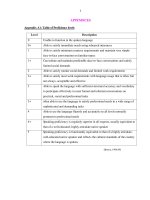
![Tài liệu Báo cáo khoa học: Expression of two [Fe]-hydrogenases in Chlamydomonas reinhardtii under anaerobic conditions doc](https://media.store123doc.com/images/document/14/br/hw/medium_hwm1392870031.jpg)
